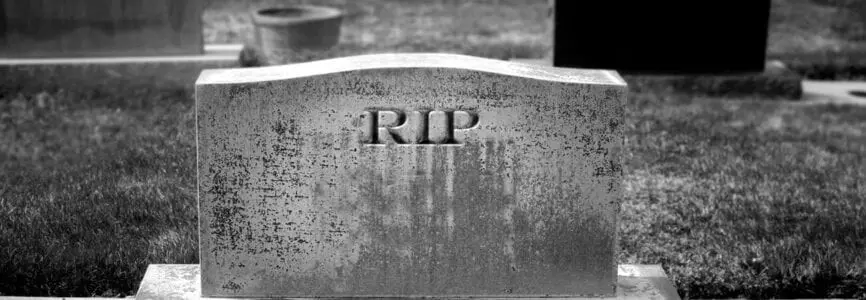Bioethics Forum Essay
Is Death in Trouble?
Death is beginning to show its age, though I hesitate to even mention that possibility. With an obviously big ego and its intimidating black cloak and scythe, it has always had some less than endearing traits: its doggedness pursuit of the aging, but also its sudden and often unpredictable destruction of human bodies by accidents, wars, plagues, murder, and disease. I am not sure how well death will tolerate any suggestion that it may now be in its dotage–so I hasten to add that I, at 86, raise the possibility in a friendly and understanding way.
How can death be aging? I offer three compelling reasons, each taking on death and winning some territory. The first is the rapid increase in average life expectancies in the past few centuries; death has been pushed back. The second is the extinction of many of the lethal infectious diseases and public health problems that killed people by the millions earlier, and research now progressing on the chronic illnesses of aging. The third is that the reveries of conquering the so-called inevitability of death are now being acted out by venturous scientists and billionaires in Silicon Valley.
Modern medicine, addicted to high-technology innovation, has in effect declared death its ultimate enemy by persuading us that every known killer disease can be eradicated. All it takes is research zeal, money, and time. And don’t listen to those killjoys who say cancer may, given the way its cells mutate, never be cured. No one believed the Wright brothers early on either. Mark Zuckerberg and his physician wife have pledged $3 billion to cure, prevent or manage all disease by the end of the century.
But isn’t there a fallacy here, and maybe more, hiding behind those examples? While perhaps a straight cure of death–which even some believe possible–might kill death, one could otherwise say that death itself is displaying what gerontologists call “successful aging.” That term means an effective physical and psychological adaptation to old age. In other words, death is doing just fine, thank you. We have yet to see a blank obituary page, but notice the elimination of a once-common phrase in those obituaries. No one is, I speculate, is allowed to die of “old age” any longer. There must be a cause of death–cancer, suicide, dementia, or whatever.
Meanwhile, down in the end-of-life trenches, some other struggles with death and aging are emerging, notably the “do more” versus “do less” battle. For at least a couple of decades there has been a strong push in health care to limit the excessive harms, medical and financial, done by over-diagnosis and overtreatment. For at least as long a time, public opinion polls have showed a strong movement away from patients wanting “everything done,” and to be allowed to die. But a Pew Research Center poll shows a sudden shift, however, with a sharp increase to having everything done to save life. No clear reason for this shift is discernible.
My guess is that the steady, ever-rising celebration of medical advances and possible cures has inspired escalating hope that, with luck and medical skill, even the seemingly impossible case is not necessarily so. There is always new technological wizardry to give us a few more minutes, or hours, or days to keep going. If the death of death is a bit too innovative even for most of the Silicon Valley entrepreneurs, there a second-best possibility: extending a healthy life span well beyond 100 or 150; and one visionary has said that 1,000 years is possible.
Paralleling that struggle is the flood-tide of states debating whether to pass legislation allowing physician-assisted suicide (aka “assisted death”). California and Colorado are the most recent additions. For many, PAS promises to offer a power to do what death itself cleverly held for thousands of years: precisely managing the type and timing of our demise. Now its timing can be chosen–to be quick, fast, and painless. The present American laws require that one be dying to take advantage of them. Yet the result has been, from one perspective, disappointing. A few thousand have ended their lives with PAS, a tiny portion of the moribund population, something that old-fashioned death, with its nasty and brutish traits, can easily live with. For those living in The Netherlands and Belgium, however, a new door has been opening, with “tired of living” now coming into acceptance as a reason for ending one’s live with a physician’s assistance.
But what if death is vanquished, or at least forced into retirement? Once that is achieved, what will we do next? Could we actually live with that success? The idea of living forever has been a long-time dream. There are plenty of scenarios available to begin working that out. Many of them, however, make a proviso for dying if one gets bored or maybe suffers from buyer’s remorse. Death could be called out of retirement to lend a hand. But if disease were banished, death could make use of some more recent threats to life such as nuclear warfare, global warming, and enhance some ancient standbys: earthquakes, war, accidents, and murder. It is too early to count death out. It may just see some interesting challenges ahead, making death’s life more interesting.
Daniel Callahan is cofounder and President Emeritus of The Hastings Center and the author, most recently, of The Five Horsemen of The Modern World: Climate, Food, Water, Disease and Obesity.













